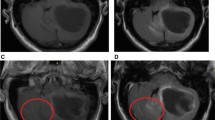Abstract
Cerebral metastases are serious complications of systemic tumors. Ischemic lesions are the main differential diagnosis of cerebral metastasis. The aim of this study is to evaluate the efficiency of signal intensity ratio (SIR) in non-contrast-enhanced fluid attenuation inversion recovery (FLAIR) sequence in the detection of cerebral metastasis. Patients with brain metastasis and evaluated with brain MRI in our institution, between 2015 and 2017, were included in this study. Brain metastases were detected in contrast-enhanced fat-saturated T1-weighted images. In pre-contrast FLAIR sequences, signal intensities (SI) from metastasis, perilesional white matter, and, if present, ischemic lesion were measured. In all patients, normal white matter SI was recorded, and SI ratio (SIR = SI lesion/SI reference white matter) was calculated for standardization. A total of 59 patients with brain metastasis detected in contrast-enhanced brain MRI were included in this study. A significant difference was detected between mean metastasis SIR and mean ischemic SIR (P = 0.001); mean perilesional SIR and mean ischemic SIR (p = 0.033); minimum metastasis SIR and minimum perilesional SIR (P = 0.012); and maximum metastasis SIR and maximum ischemic SIR (p = 0.04). SIR of hyperintense lesions in FLAIR sequences may be helpful in differentiating brain metastasis from ischemic WM lesions, especially in patients contrast media is contraindicated.





Similar content being viewed by others
Data Availability
Not applicable.
Code Availability
Not applicable.
References
Fink KR, Fink JR. Imaging of brain metastases. Surg Neurol Int. 2013;4(Suppl 4):S209.
Pope WB. Brain metastases: neuroimaging. Handbook of clinical neurology. Elsevier; 2018. p. 89–112.
Tomura N, Narita K, Takahashi S, Otani T, Sakuma I, Yasuda K, et al. Contrast-enhanced multi-shot echo-planar FLAIR in the depiction of metastatic tumors of the brain: comparison with contrast-enhanced spin-echo T1-weighted imaging. Acta Radiol. 2007;48(9):1032–7.
Ercan N, Gultekin S, Celik H, Tali TE, Oner YA, Erbas G. Diagnostic value of contrast-enhanced fluid-attenuated inversion recovery MR imaging of intracranial metastases. Am J Neuroradiol. 2004;25(5):761–5.
Chutinet A, Rost NS. White matter disease as a biomarker for long-term cerebrovascular disease and dementia. Curr Treat Options Cardiovasc Med. 2014;16(3):292.
Zhao DQ, Wang ZW, Cheng Y, Yuan Z, Rene F, Liu H, et al. A DTI study of leukoaraiosis and the differential diagnosis between leukoaraiosis and acute lacunar infarction. CNS Neurosci Ther. 2019;25(9):1064.
Çakır Ç, Gençhellaç H, Temizöz O, Polat A, Şengül E, Duygulu G. Diffusion weighted magnetic resonance imaging for the characterization of solitary pulmonary lesions. Balkan Med J. 2015;32(4):403.
Uto T, Takehara Y, Nakamura Y, Naito T, Hashimoto D, Inui N, et al. Higher sensitivity and specificity for diffusion-weighted imaging of malignant lung lesions without apparent diffusion coefficient quantification. Radiology. 2009;252(1):247–54.
Balériaux D, Colosimo C, Ruscalleda J, Korves M, Schneider G, Bohndorf K, et al. Magnetic resonance imaging of metastatic disease to the brain with gadobenate dimeglumine. Neuroradiology. 2002;44(3):191–203.
Tosoni A, Ermani M, Brandes AA. The pathogenesis and treatment of brain metastases: a comprehensive review. Crit Rev Oncol Hematol. 2004;52(3):199–215.
Boonzaier NR, Larkin TJ, Matys T, van der Hoorn A, Yan J-L, Price SJ. Multiparametric MR imaging of diffusion and perfusion in contrast-enhancing and nonenhancing components in patients with glioblastoma. Radiology. 2017;284(1):180–90.
Pekmezci M, Perry A. Neuropathology of brain metastases. Surg Neurol Int. 2013;4(Suppl 4):S245.
Fazekas F, Kleinert R, Offenbacher H, Schmidt R, Kleinert G, Payer F, et al. Pathologic correlates of incidental MRI white matter signal hyperintensities. Neurology. 1993;43(9):1683.
Blystad I, Warntjes J, Smedby Ö, Lundberg P, Larsson E-M, Tisell A. Quantitative MRI using relaxometry in malignant gliomas detects contrast enhancement in peritumoral oedema. Sci Rep. 2020;10(1):1–9.
Kubota T, Yamada K, Kizu O, Hirota T, Ito H, Ishihara K, et al. Relationship between contrast enhancement on fluid-attenuated inversion recovery MR sequences and signal intensity on T2-weighted MR images: visual evaluation of brain tumors. J Magn Reson. 2005;21(6):694–700.
Zimm S, Wampler GL, Stablein D, Hazra T, Young HF. Intracerebral metastases in solid-tumor patients: natural history and results of treatment. Cancer. 1981;48(2):384–94.
Schouten LJ, Rutten J, Huveneers HA, Twijnstra A. Incidence of brain metastases in a cohort of patients with carcinoma of the breast, colon, kidney, and lung and melanoma. Cancer. 2002;94(10):2698–705.
Navarro-Olvera J, Arinez-Barahona E, Esqueda-Liquidano M, Munoz-Cobos A. Brain metastases: literature review. Revista Médica del Hospital General de México. 2017;80(1):60–6.
Author information
Authors and Affiliations
Contributions
Dilek Sağlam: acquisition, analysis and interpretation of data, drafting the work, final approval, and agreement for all aspects of the work
Hediye Pınar Günbey: acquisition, analysis and interpretation of data, drafting the work, final approval, and agreement for all aspects of the work
Serap Yücel: acquisition, analysis and interpretation of data, drafting the work, final approval, and agreement for all aspects of the work
Aslı Tanrıvermiş Sayıt: acquisition, analysis and interpretation of data, drafting the work, final approval, and agreement for all aspects of the work
Kerim Aslan: acquisition, analysis and interpretation of data, drafting the work, final approval, and agreement for all aspects of the work
Lütfi İncesu: acquisition, analysis and interpretation of data, drafting the work, final approval, and agreement for all aspects of the work
Corresponding author
Ethics declarations
Ethics Approval
Granted from Ondokuz Mayıs University Clinical Research Ethical Committee (study number:2016/367).
Consent to Participate
Granted.
Consent for Publication
Written consent was obtained for publication.
Conflict of Interest
The authors declare no competing interests.
Additional information
Publisher's Note
Springer Nature remains neutral with regard to jurisdictional claims in published maps and institutional affiliations.
This article is part of the Topical Collection on Imaging
Rights and permissions
About this article
Cite this article
Sağlam, D., Günbey, H.P., Yücel, S. et al. Signal Intensity Ratio in Fluid Attenuation Inversion Recovery Sequences in Determining Cerebral Metastasis on Non-contrast-Enhanced Magnetic Resonance Imaging. SN Compr. Clin. Med. 4, 27 (2022). https://doi.org/10.1007/s42399-021-01089-7
Accepted:
Published:
DOI: https://doi.org/10.1007/s42399-021-01089-7




